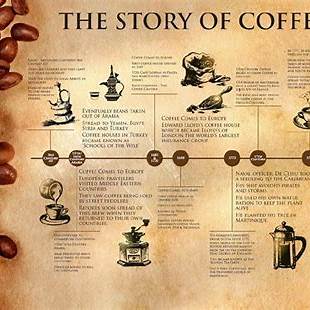Coffee is a drink enjoyed by billions, but few know the remarkable journey it took from wild forests in Africa to becoming a global staple. This article traces the fascinating history of coffee—from its legendary discovery to its widespread cultural and economic influence today.
The Legend of Kaldi and His Energetic Goats
According to popular legend, coffee was discovered in Ethiopia during the 9th century by a goat herder named Kaldi. He noticed that his goats became unusually lively after eating the bright red berries from a specific bush. Curious, Kaldi sampled the berries himself and experienced a sudden burst of energy.
Monks at a nearby monastery learned about the berries and began using them to stay awake during long prayers. This early discovery set the stage for coffee’s journey beyond Africa.
The Spread of Coffee to the Arab World
By the 15th century, coffee cultivation and trade had spread to the Arabian Peninsula. It became a significant part of Yemeni culture, especially in Mokha, a port city that became synonymous with coffee exports.
Muslim pilgrims visiting Mecca played a key role in introducing coffee to new regions. The drink became an integral part of Islamic culture, as it helped worshippers stay awake during extended prayer sessions.
In this period, coffee was prepared as a hot beverage known as “qahwa”, an Arabic term that later evolved into the word “coffee.”
The Rise of Coffeehouses: Cultural and Intellectual Hubs
By the 16th century, coffeehouses—known as “qahveh khaneh”—began appearing across the Middle East. These establishments quickly gained popularity as places where people gathered to:
- Discuss politics
- Share poetry
- Play games like chess
- Enjoy live music
These early coffeehouses set the precedent for coffee’s association with intellectual exchange and social interaction.
However, not everyone was a fan. Some religious and political leaders tried to ban coffee, fearing that these gatherings could foster dissent. Despite such efforts, coffee’s popularity continued to grow.
Coffee Reaches Europe
Coffee made its way to Europe in the 17th century, first arriving in Venice through trade with the Ottoman Empire. Initially met with suspicion and even labeled as “Satan’s drink” by some clergy, coffee eventually gained acceptance after Pope Clement VIII reputedly blessed it, declaring it too delightful to be sinful.
Coffeehouses soon flourished across major European cities:
- England: Known as “penny universities” because, for the price of a cup, one could engage in stimulating conversation.
- France: The famous Café Procope became a meeting place for writers and intellectuals such as Voltaire and Rousseau.
- Vienna: The introduction of milk and sugar led to the creation of the Viennese coffee tradition.
Coffee Fuels the Age of Enlightenment
Coffeehouses became vital venues during the Age of Enlightenment. Thinkers, philosophers, and revolutionaries gathered to exchange ideas, fueling movements that would reshape societies, such as:
- The French Revolution
- The American Revolution
In England, coffeehouses contributed to the rise of businesses like Lloyd’s of London, which began as a coffeehouse frequented by merchants and ship owners.
The Global Expansion of Coffee Cultivation
Initially monopolized by Arab traders, coffee cultivation expanded worldwide as European colonial powers sought to grow it in their territories.
Key Moments in Coffee’s Agricultural Expansion:
- 17th century: The Dutch smuggled coffee plants to Java in Indonesia, establishing the first successful European coffee plantation.
- 18th century: Coffee plants reached the Caribbean and South America, particularly Brazil, which would later become the world’s largest coffee producer.
- Africa: Although coffee originated here, its large-scale commercial cultivation was dominated by European settlers.
This expansion made coffee a global commodity and one of the most important cash crops in international trade.
Coffee’s Role in Modern Society
Today, coffee is more than just a beverage—it’s a cultural phenomenon:
- A daily ritual for millions
- A centerpiece for social gatherings
- A driver of economic development in many countries
Globally, coffee supports the livelihoods of over 125 million people, particularly smallholder farmers in developing nations.
The Third Wave Coffee Movement
In recent decades, the Third Wave Coffee movement has redefined coffee culture. Emphasizing specialty coffee, this movement focuses on:
- Sourcing: Traceable, ethically grown beans
- Quality: Meticulous attention to roasting and brewing
- Experience: Treating coffee as an artisanal product rather than a commodity
This movement has introduced many consumers to single-origin coffees and alternative brewing methods like pour-over and AeroPress.
The Future of Coffee
While coffee remains globally beloved, it faces challenges such as:
- Climate change affecting crop viability
- Economic instability among small farmers
- Increasing demand requiring sustainable solutions
Efforts are underway to develop climate-resilient coffee varieties and improve supply chain sustainability to ensure coffee’s place in our lives for generations to come.
Final Thoughts
From a goat herder’s accidental discovery to a beverage that connects cultures across the globe, coffee’s journey is a testament to its enduring appeal. Its story is one of innovation, adaptation, and global influence, woven into the fabric of human history.
Next time you enjoy your cup of coffee, remember the centuries of history and cultural evolution that made it possible.
